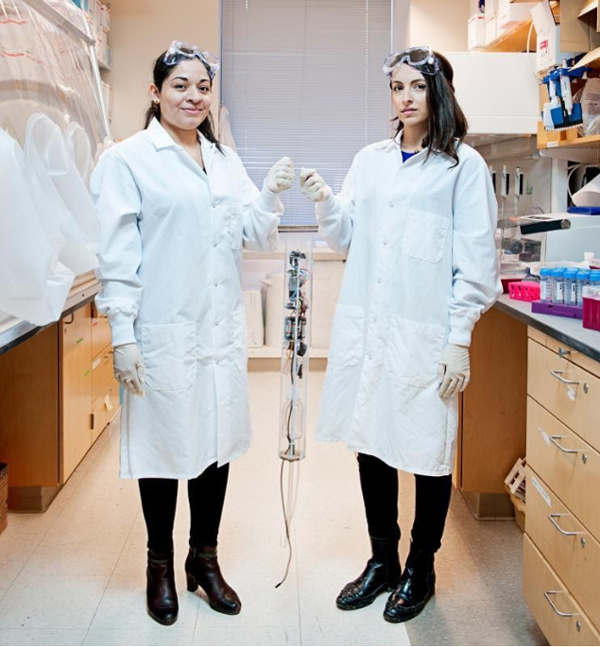|
|

|
  
Top Stories
Update 2020/5/1

MASSACHUSETTS START-UP'S WASTEWATER ANALYSIS
POINTS TO QUICKER DETECTION OF COVID-19 VIRUS
By Suzanne Forcese
In 2017, Canadian researcher and architect, Newsha Ghaeli, teamed up with Mexican biologist, Mariana Matus at the Massachusetts Institute of Technology (MIT) Department of Innovative Initiative, to found Biobot Analytics. Inspired by the potential of wastewater epidemiology, Biobot is the first company in the world to commercialize data from sewage. The team of scientists and designers are on a mission to create real-time public health profiles of urban areas by sampling a city’s wastewater using their patent-pending pipeline of robotics and analytics.
The interdisciplinary team spear-headed the development of a product to map opioid consumption in cities through wastewater-based epidemiology. By treating sewage as a collective urine and stool sample to look for specific molecules found in opioids the researchers have been able to differentiate between drugs flushed down the toilet and those ingested by humans. The technology allows researchers to analyze patterns of ongoing drug use and evaluate the efficacy of intervention programs.
“We believe that wastewater is a very important source of public health information. It has already been successfully used to look at polio virus outbreaks as well as consumption of drugs,” Biobot Co-founder, Mariana Matus said.
Biobot has now stepped up to the plate in the current pandemic. “We are designed to respond to whatever is a public health priority,” Co-founder Newsha Ghaeli, said.

Mariana Matus & Newsha Ghaeli, Biobot Co-Founders
Why test for SARS-CoV-2 in sewage?
Matus says, “The virus RNA can be detected in stool.”
According to a research study, published March 2020, “The live virus was detected in feces,” ( ‘Detection of SARS-CoV-2 in Different Types of Clinical Specimens’, Wang et al).
“The virus RNA can be detected in sewage,” Matus continues.
The Biobot team published in medRxiv (April 07, 2020) the first study to estimate the number of people infected with COVID-19 based on the levels of SARS-CoV-2 quantified in sewage.
Sewage suggests that a much larger number of people are infected with COVID-19.
“We collected sewage samples from a large metropolitan area in the state of Massachusetts. On March 25, 2020, the area represented by the sample had approximately 446 confirmed cases of COVID-19. Based on our sewage analysis, we estimate that up to 115,000 people are infected and shedding the SARS-CoV-2 virus.”
Estimating the true number of COVID-19 cases is extremely challenging. Why does sewage analysis show a higher number of cases than confirmed cases from individual testing?
“At this time, our prevalence estimates are a back of the envelope exercise and there’s much work to be done to improve accuracy. Beyond our own technical limitations, there are possible explanations why sewage is giving a higher number of infected people as compared to confirmed cases:
- People with mild symptoms may not go to the hospital, or get tested
- There is growing evidence that COVID-19 could have a large asymptomatic population
- Limited access to clinical testing, and
- A lag in reporting confirmed cases”
“Data can be used to estimate COVID-19 prevalence which is a complementary piece of information to the clinical testing that we do today.”
Having now launched its COVID-19 response program, Biobot is working with over 150 facilities, in over 30 states, representing approximately 10% of the population.
“The team is heads down making sure Biobot is able to reach as many communities as possible as part of the COVID-19 response program,” Sarah Pugsley, communications director, told WaterToday.
“We provide a sewage sampling kit that treatment plants can use,” Matus said. “They send the samples back to us. We run lab analyses looking for the genetic signature of the virus through a technique called qPCR to quantify the level of SARS-CoV-2 virus in the sewage sample. We use the virus genome to make a standard curve. And we end up with copies /mL of sewage. Finally, we provide a customer report to help people understand approximately how many infections are happening in their community.”
Amy Kirby, Environmental Biologist with the CDC (Centre For Disease Control) has stated that there is no conclusive data that the virus shed in stool is infectious. The Biobot team is taking an extra precaution however through a pasteurization process to effectively destroy any virus in order to make handling in the lab more innocuous.
“We are also now building trending data since most of the treatment plants in our program are providing weekly samples.” Biobot is also working to build comparisons across locations. “We hope this information can complement existing epidemiological data to better understand when to reopen cities as well as an early warning system for the re-emergence of the virus later this year.”
Biobot believes that collecting data from sewers will enable communities to measure the scope of the outbreak independent from patient testing. They will also be better equipped to anticipate factors such as hospital capacity, hospital readiness, and the necessity of public health interventions.
suzanne.f@watertoday.ca
|
|
|
Have a question? Give us a call 613-501-0175
All rights reserved 2025 - WATERTODAY - This material may not be reproduced in whole or in part and may not be distributed,
publicly performed, proxy cached or otherwise used, except with express permission.
|
| |